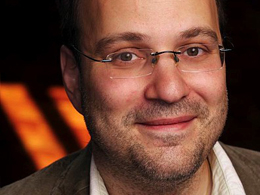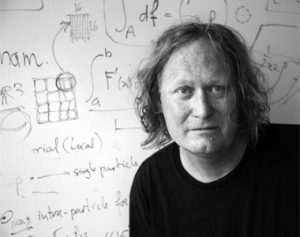Thoughts on Computational Photography
Fredo Durand – MIT
Session details: Tuesday 25 April, 11:00 - 12:00 Room: Auditorium Lumière

Astract: Computational photography is based on the idea that computation has a central role in image formation. The final image we get is not a simple projections of light onto a sensor but undergoes deep calculations. This allows us to gather visual information that would be hard or impossible through optics alone. In this talk, I reflect on the successes and challenges of computational photography, and lay out research opportunity lying ahead.
Bio: Frédo Durand is a professor of Electrical Engineering and Computer Science at the Massachusetts Institute of Technology, and a member of the Computer Science and Artificial Intelligence Laboratory (CSAIL). He received his PhD from Grenoble University, France, in 1999, supervised by Claude Puech and George Drettakis. From 1999 till 2002, he was a post-doc in the MIT Computer Graphics Group with Julie Dorsey.
He works both on synthetic image generation and computational photography, where new algorithms afford powerful image enhancement and the design of imaging system that can record richer information about a scene. His research interests span most aspects of picture generation and creation, with emphasis on mathematical analysis, signal processing, and inspiration from perceptual sciences. He co-organized the first Symposium on Computational Photography and Video in 2005, the first International Conference on Computational Photography in 2009, and was on the advisory board of the Image and Meaning 2 conference. He received an inaugural Eurographics Young Researcher Award in 2004, an NSF CAREER award in 2005, an inaugural Microsoft Research New Faculty Fellowship in 2005, a Sloan fellowship in 2006, a Spira award for distinguished teaching in 2007, and the ACM SIGGRAPH Computer Graphics Achievement Award in 2016. He is on the scientific advisory board of light.co, Technicolor, Shaper Tools, and Moju Labs.
The joy of computer graphics programming
Bruno Levy – Inria Nancy Grand-Est
Session details: Wednesday 26 April, 11:00 - 12:00 Room: Auditorium Lumière

It’s a lot of fun to do research in a vibrant domain such as computer graphics. In my personal experience, a great part of the fun comes from -programming-, an activity that lies at the interface between the mathematics and the hardware, and that interplays with both in subtle and fascinating patterns. I’ll try to illustrate the fun of programming with tips and tricks on different aspects of computer graphics programming, examplified with routines of the GEOGRAM open-source library. I will also demonstrate their use in some of my on-going research projects on spectral geometry, volumetric parameterization and optimal transport.
Bio: Bruno Levy is a senior researcher with Inria, and the head of the ALICE group (geometry processing and computer fabrication) that he created in 2004 (now 8 faculties). He received the Inria/French Academy of Sciences young researcher award in 2011. He is associate editor for ACM TOG and Graphical Models, and he is a member of the steering committee of SMA/SPM. He was paper co-chair of Eurographics 2014, Pacific Graphic 2013, SGP 2010, SPM 2008 and 2007. His main research topic is geometry processing. In the past, he focused on mesh parameterization, texture mapping and conversion between representations (e.g. mesh to Splines). More recently, in the frame of his ERC projects GOODSHAPE and VORPALINE, he worked on sampling (vector quantization) and meshing (isotropic, anisotropic, hex-dominant mesh generation). His latest research concerns efficient numerical algorithms for solving partial differential equations (such as Monge-Ampere involved in optimal transport) and practical geometric algorithms (robust predicates, anisotropic Voronoi diagrams in high dimensions and hexahedral meshing).
What is Time?
Jos Stam – Autodesk
Session details: Friday 28 April, 11:00 - 12:00 Room: Auditorium Lumière

Abstract: Menu Prix Fixe (vegetarian)
- Entree: Ten year old aged Nucleus.
- Main course: Observations about time à la sauce computer graphics.
- Dessert: Optimization with a sprinkle of dual numbers.
- Suggested wine: « The Art of Fluid Animation. » Cuvee 2015. Toronto, Canada.
This is how our Chef, coming to your comfy seat, will explain the three courses.
Firstly, Nucleus is a unified dynamics solver that I first prepared and presented at a keynote talk Eurographics in Vienna in 2006. Today we will show how this solver, implemented in Autodesk MAYA, has been used in the industry. I will also show different extensions that have been implemented since then. Animations will be shown. But please keep your appetite for the other courses.
Then you will be served la piece de resistance. Ah Time. Qu’est ce que c’est? A simple question with a long history and sometimes surprising consequences. As in, there is no definite answer but exploring this question leads to interesting research. Time is important in computer graphics. Obviously in simulation but even there, there are surprises. I will illustrate some of these concepts using visuals and some live demos. This will be short a la Nouvelle Cuisine.
Finally, for dessert I will talk about some techniques to optimize problems at the code level. You can implement complex math differentials with simple code. In this talk I will also serve you some optimization frameworks I have been exploring recently which can potentially solve for dynamics and create geometrical shapes. I will also mention Georges Perec, the guy who wrote a readable novel wihout the letter « e. »
About the wine. The beauty is that you can sample it before hand : https://www.autodeskresearch.com/publications/art-fluid-animation
Bon appétit messieurs dames.
This meal will be served in the culinary capital of France: Lyon on April 28, 2017.
Bio: Jos Stam was born in the Netherlands and educated in Geneva, Switzerland, where he received dual Bachelor degrees in computer science and pure mathematics. In 1989, Stam moved to Toronto, Canada, where he completed his Masters and Ph.D. degrees in computer science. After that he pusrsued postdoctoral studies as a ERCIM fellow at INRIA in France and at VTT in Finland. In 1997 Stam joined the Alias Seattle office as a researcher and stayed there until 2003 to relocate to Alias’ main office in Toronto. Stam is now employed with Autodesk as a Principal Scientist as part of Autodesk’s acquisition of Alias in 2006.
Stam’s research spans several areas of computer graphics: natural phenomena, physics-based simulation, rendering and surface modeling, especially subdivision surfaces. He has published papers in all of these areas in journals and at conferences, most notably at the annual SIGGRAPH conference. In 2005 Stam was awarded one of the most prestigeous awards in computer graphics: the SIGGRAPH Computer Graphics Achievement Award. And for the impact his work on subdivision surfaces and fluid simulation has had on the movie industry, he was awarded two Technical Achievement Awards from the Academy of Motion Picture Arts and Sciences. Also known as « SciTech Oscars » in 2006 and 2008.
Stam also created a solver called Nucleus which he first presented at a keynote talk at Eurographics in Vienna in 2006. Nucleus is a unified simulation framework for computer graphics implemented in our MAYA software.
Stam has also given many keynote/invited presentations in many continents except for Antartica and Africa.
Stam recently published a book called « The Art of Fluid Animation: » A down to earth and whacky overview of his work on fluid dynamics from an animation and computer graphics perspective.
